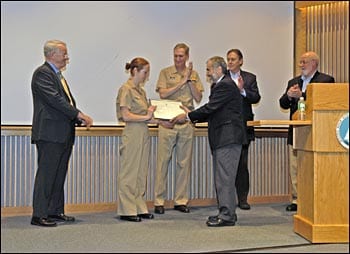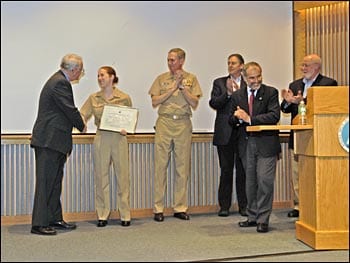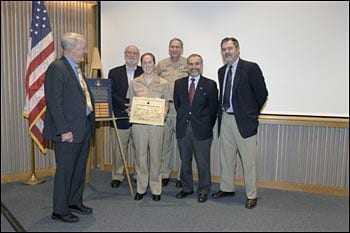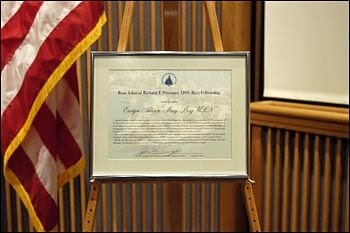WHOI Establishes Award to Recognize Contributions of Navy Admiral, Oceanographer
April 1, 2005
A former Oceanographer of the Navy and Rear Admiral who headed Marine Operations at the Woods Hole Oceanographic Institution (WHOI) for 14 years has been honored by the Institution with the establishment of the Rear Admiral Richard F. Pittenger, USN (Ret) Fellowship.
The Pittenger Fellowship was established by the Institution to honor his contributions to the Institution and will be awarded each year to a United States naval officer admitted to the MIT/WHOI Joint Program in Oceanography and Applied Ocean Science and Engineering.
The first recipient is Ensign Allison May Berg, USN, a master’s degree student in the MIT/WHOI Joint Program in Oceanography and Applied Ocean Science and Engineering. Ensign Berg was presented the award at a ceremony March 29 at WHOI following a presentation of naval oceanography by RADM Steven J. Tomaszeski, Oceanographer of the Navy. Berg is advised by Eugene Terray of the Applied Ocean Physics and Engineering Department.
Berg is taking classes at MIT and WHOI and has begun working on her research project on sonic detection and ranging (SODAR). During the next year she plans to collect wind profile data in the marine atmospheric boundary layer using a SODAR (sonic detection and ranging) that is mounted on an oceanographic buoy.
“If SODARs could effectively be used on oceanographic buoys, then wind profile data could be obtained almost anywhere in the ocean, which would ultimately help with weather predictions,” she said of her research focus. “What I am learning in my classes and what I will learn in my research will give me a good base of knowledge that I can take with me into the United States Navy’s fleet.”
Berg hopes to complete her degree in September 2006 and join the USS Momsen (DDG 92) in Everett, Washington.
“Admiral Pittenger served with distinction in a 37-year career with the United States Navy that culminated in his appointment as Oceanographer of the Navy. In that position, he was a strong supporter of science and engineering education for naval officers,” WHOI President and Director Robert Gagosian said in presenting the award to Ensign Berg. “He was an especially strong advocate for several officers who earned graduate degrees in the MIT/WHOI Joint Program. This award is a fitting way to recognize his contributions to the Institution and to the U.S. Navy for years to come.”
After his retirement from the Navy, Admiral Pittenger joined the Woods Hole Oceanographic Institution staff in 1990 and continued to promote graduate education of naval officers in ocean sciences and engineering.
A citation on a plaque outside the Academic Programs office in WHOI’s Clark Laboratory reads in part: “As Oceanographer of the Navy and throughout his years at WHOI, Admiral Pittenger played a key role in ensuring access to modern, first-class research vessels and vehicles in the United States academic fleet and at WHOI for present and future generations of graduate students and their advisors.”
“This is a much deserved recognition of all Dick Pittenger has contributed to the nation, to the Navy, to oceanography and to WHOI,” Vice President for Academic Programs and Dean John Farrington said. “We are delighted to have the Naval Officer graduate students in the MIT/WHOI Joint Program. They contribute in many ways to the learning environment and ongoing ocean science and ocean engineering research at WHOI.”
A native of Nebraska, Pittenger grew up in Tacoma, Washington, and was commissioned as an ensign in the U.S. Navy in 1958 after graduating from the U.S. Naval Academy. He served on active duty in the U.S. Navy for 32 years before retiring in October 1990 after serving for two years as Oceanographer of the Navy. He commanded a minesweeper in Vietnam, a frigate and a destroyer squadron, and held various other fleet assignments on destroyers, guided missile destroyers, frigates and the Navy’s most advanced antisubmarine warfare surface ship.
In 1984 he was promoted to Rear Admiral and became Chief of Staff of U.S. Naval Forces in Europe and Deputy U.S. Commander for the Eastern Atlantic. In 1986 he became Director, of the navy’s Antisubmarine Warfare (ASW) Division and received his second star as Rear Admiral in 1987. As Oceanographer of the Navy from 1988 to 1990 he oversaw the U.S. Naval Observatory, which had stations in the U.S. and New Zealand, and the U.S. Naval Oceanography Command, which at the time was responsible for 61 oceanographic facilities around the world, 12 oceanographic survey ships and three survey aircraft.
His operational experience in ASW and his postgraduate degree in underwater acoustics brought together modern technologies with the oceanographic needs of the operating fleet. During his tenure as Oceanographer of the Navy, RADM Pittenger continued the modernization of the Navy’s oceanographic fleet and is recognized for his efforts in such areas as the standardization of oceanographic models for use by forces afloat for antisubmarine warfare, the increased support for emerging ASW systems, the declassification of the National Oceanic and Atmospheric Administration’s Exclusive Economic Zone coastal charts, and for the acquisition of the Navy’s Cray supercomputers for oceanographic modeling and forecasting.
Pittenger joined the WHOI staff in October 1990 as Arctic Research Coordinator and was soon named Associate Director and later Vice President for Marine Operations. He oversaw a major upgrade and lengthening of the Institution’s largest research vessel, the now 279-foot Knorr, and modernization of the 177-foot Oceanus. The 210-foot Atlantis II was retired and sold, replaced by the new 274-foot Atlantis, support vessel for the three-person submersible Alvin. A successful proposal was submitted to replace Alvin with a deeper diving submersible, announced in August 2004, and the 60-foot coastal vessel Tioga joined the fleet in April 2004.
Pittenger retired from WHOI in June 2004 but continues to guide the Institution in its fleet replacement efforts and share the experience and expertise of a distinguished naval career.
The father of four grown children and grandfather of three, he and his wife, Marjorie, a native of Fall River, live in Bourne.
WHOI is a private, independent marine research and engineering, and higher education organization located in Falmouth, MA. Its primary mission is to understand the oceans and their interaction with the Earth as a whole, and to communicate a basic understanding of the ocean’s role in the changing global environment. Established in 1930 on a recommendation from the National Academy of Sciences, the Institution is organized into five departments, interdisciplinary institutes and a marine policy center, and conducts a joint graduate education program with the Massachusetts Institute of Technology.




